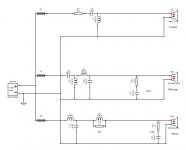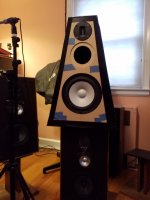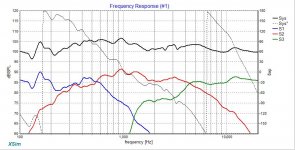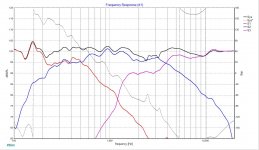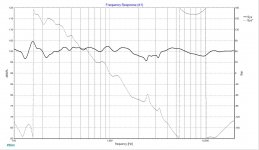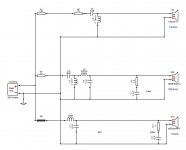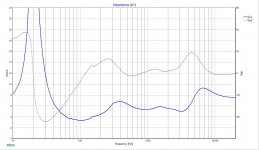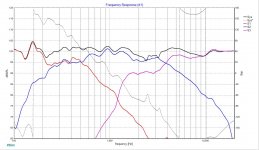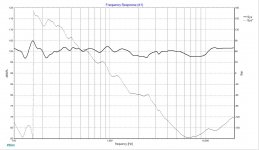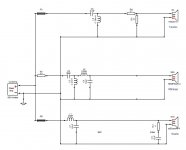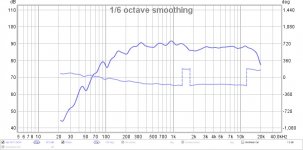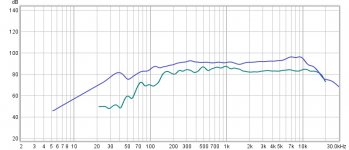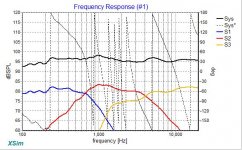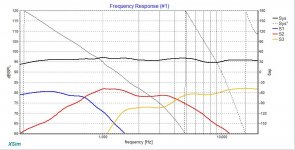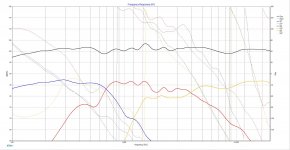I have the drivers and I am running them in a test enclosure now, connectted to a DSP and a three channel amp. Right now it is being crossed at 500 and 4K and sounds fine. The baffle is a trapezoid. The drivers are as follows.
SB23CACS45-4 8" Ceramic Woofer
SB12MNRX2-25-4 4" Norex Midrange
Fountek NeoCD1.0 True ribbon tweeter
My measurements aren't too good, my office is small and cluttered so there are a lot of hills and valleys. I will haul it all outside at some point and get a cleaner picture. Here is my Xsim3d (Had to zip it)file and some pictures.
SB23CACS45-4 8" Ceramic Woofer
SB12MNRX2-25-4 4" Norex Midrange
Fountek NeoCD1.0 True ribbon tweeter
My measurements aren't too good, my office is small and cluttered so there are a lot of hills and valleys. I will haul it all outside at some point and get a cleaner picture. Here is my Xsim3d (Had to zip it)file and some pictures.
Attachments
I will take a look at it. How low or high do you want to cross the tweeter... I know nothing about the fountek ribbon... I looks like its impedance peaks out at about 1.2 k... It looks like you are shooting for about 3.5k... yes?
ok - I think this looks good, given the measurements you have provided.
A couple of thoughts...
Perhaps we should use a "listening window" measurement in the simulation, instead of just an on-axis. I suspect some of the tweeter roughness (and maybe the midrange roughness) is due to diffraction effects, and averaging the response over a window might smooth things out. Floyd Toole recommended a series of measurements +/- 30 degrees horizontal and +/- 15 degrees vertical. This maybe particularly important with a ribbon tweeter.
A couple of thoughts...
Perhaps we should use a "listening window" measurement in the simulation, instead of just an on-axis. I suspect some of the tweeter roughness (and maybe the midrange roughness) is due to diffraction effects, and averaging the response over a window might smooth things out. Floyd Toole recommended a series of measurements +/- 30 degrees horizontal and +/- 15 degrees vertical. This maybe particularly important with a ribbon tweeter.
Attachments
Some room input, woofer 400Hz and down, at least making it a challenge to pick the reference level.
Although I'm open to Jims listening window call, I think you could do worse than to use gated measurements.
Although I'm open to Jims listening window call, I think you could do worse than to use gated measurements.
I did some measurements in my living room, still to cold and wet to go outside. I think I found the problem with the dip in the 1k to 4k range. I seems to be the driver, I changed stuffing, the shape and size of the mid enclosure and it is still there. Here is what I found in near field, 4 inches from the driver. The single measurement is the near field, no changes made the dip go away. The picture with two measurements compares the manufactures IB (blue) and my measurement at 30 inches (green). I can see a little dip in the blue, but the green has a 3db drop off from 1k to 2k. I does stay nice and flat after that. So, is this just a bad driver, I hope not, I waited 3 months for SB to ship it, or is there a way to fix this? Currently I'm crossing the tweeter at 4k, pretty much what the manufacture recommends, I guess I can go lower to help fill the hole in the mid.
Attachments
What was your gating on it?
500 ms, I tried 3 ms and 5 ms. Any advice? I've attached the mdat files from REW.
Attachments
5 ms is a good starting point for a quasi-anechoic gated measurement. It equals sound travelling through 66 inches (33 inches down to the floor, 33 inches back up to the mic).
500 ms is basically no gating at all. You are picking up all room response over the full frequency range. This would be appropriate if you could suspend both the speaker and the mic 25 feet up into the air...otherwise it is too much.
For a baffle of your size, I would put the mic 24 inches from the baffle, at the level of the middle of the tweeter. I would make sure that no reflecting surface is any closer to the driver or the mic than the distance to the floor. In other words, the floor is the one thing you can't do anything about, so make sure everything else is further away than the floor.
500 ms is basically no gating at all. You are picking up all room response over the full frequency range. This would be appropriate if you could suspend both the speaker and the mic 25 feet up into the air...otherwise it is too much.
For a baffle of your size, I would put the mic 24 inches from the baffle, at the level of the middle of the tweeter. I would make sure that no reflecting surface is any closer to the driver or the mic than the distance to the floor. In other words, the floor is the one thing you can't do anything about, so make sure everything else is further away than the floor.
5 ms is a good starting point for a quasi-anechoic gated measurement. It equals sound travelling through 66 inches (33 inches down to the floor, 33 inches back up to the mic).
500 ms is basically no gating at all. You are picking up all room response over the full frequency range. This would be appropriate if you could suspend both the speaker and the mic 25 feet up into the air...otherwise it is too much.
For a baffle of your size, I would put the mic 24 inches from the baffle, at the level of the middle of the tweeter. I would make sure that no reflecting surface is any closer to the driver or the mic than the distance to the floor. In other words, the floor is the one thing you can't do anything about, so make sure everything else is further away than the floor.
Here it is with all gated to 5 ms.
Attachments
I think this reference paper should help - Box.
To very briefly summarize, farfield is trying to pick up baffle effects but not room effects. The mic should be therefore 3-5 times the cone diameter away from the driver and should also be at least 2 times the baffle width away. If your listening axis is the tweeter, then you want to likewise set up your mic in front of that driver to take all your farfield measuremnts. Mic distance will be defined then by the largest driver, the woofer. Three to 5 times the cone diameter is about 24-40". Your baffle width at your woofer looks to probably be somewhere around 10". Two times that is 20" so I'd agree with hifijim, a minimum of about 24" away will do the job.
If you choose 5ms for gating, sound will travel about 5.65' in that time (speed of sound=1130ft/sec and speed =d/t). So as long as the path length from the drivers to an object and back to the mic is longer than that, room effects (not including the floor) won't reach the mic. But if you follow the rest of the paper's instructions for nearfield measurements, chances are you can splice/blend the floor effects out of the final response.
I would suggest giving that paper a solid read or re-read and doing all your measurements over again before proceeding any further.
To very briefly summarize, farfield is trying to pick up baffle effects but not room effects. The mic should be therefore 3-5 times the cone diameter away from the driver and should also be at least 2 times the baffle width away. If your listening axis is the tweeter, then you want to likewise set up your mic in front of that driver to take all your farfield measuremnts. Mic distance will be defined then by the largest driver, the woofer. Three to 5 times the cone diameter is about 24-40". Your baffle width at your woofer looks to probably be somewhere around 10". Two times that is 20" so I'd agree with hifijim, a minimum of about 24" away will do the job.
If you choose 5ms for gating, sound will travel about 5.65' in that time (speed of sound=1130ft/sec and speed =d/t). So as long as the path length from the drivers to an object and back to the mic is longer than that, room effects (not including the floor) won't reach the mic. But if you follow the rest of the paper's instructions for nearfield measurements, chances are you can splice/blend the floor effects out of the final response.
I would suggest giving that paper a solid read or re-read and doing all your measurements over again before proceeding any further.
I think this reference paper should help - Box.
To very briefly summarize, farfield is trying to pick up baffle effects but not room effects. The mic should be therefore 3-5 times the cone diameter away from the driver and should also be at least 2 times the baffle width away. If your listening axis is the tweeter, then you want to likewise set up your mic in front of that driver to take all your farfield measuremnts. Mic distance will be defined then by the largest driver, the woofer. Three to 5 times the cone diameter is about 24-40". Your baffle width at your woofer looks to probably be somewhere around 10". Two times that is 20" so I'd agree with hifijim, a minimum of about 24" away will do the job.
If you choose 5ms for gating, sound will travel about 5.65' in that time (speed of sound=1130ft/sec and speed =d/t). So as long as the path length from the drivers to an object and back to the mic is longer than that, room effects (not including the floor) won't reach the mic. But if you follow the rest of the paper's instructions for nearfield measurements, chances are you can splice/blend the floor effects out of the final response.
I would suggest giving that paper a solid read or re-read and doing all your measurements over again before proceeding any further.
I've read Jeff's article many times, I will read it again. The woofer's cone is 7 inches and the baffle is 13 inches at the center of the woofer. So that gives 21 - 26 inches so how far off is my 30 inches? I can go through the splicing of the near field and gated measurements, but I was under the impression that this will just make the low frequency part of the measurement more accurate. So I figured since their isn't anything I can do in a passive crossover to improve the bass response why bother with the near field measurement and splicing. Am I wrong?
right, so if you were using a 500ms gate for farfield I had to question your methodology.
You need an accurate blending of nearfield and farfield that includes baffle effects but that doesn't contain the room effects. You should start your sim after that with setting the woofer level which will be at whatever SPL level the woofer is at at about 100-200Hz. To do that, you need that blended response. Thus, yes you need to follow exactly what Jeff has described in his paper.
You need an accurate blending of nearfield and farfield that includes baffle effects but that doesn't contain the room effects. You should start your sim after that with setting the woofer level which will be at whatever SPL level the woofer is at at about 100-200Hz. To do that, you need that blended response. Thus, yes you need to follow exactly what Jeff has described in his paper.
Mtidge - I think your latest FR curve looks pretty good. I don't think I would change anything based on that measurement. Measurements can only take you so far, and when you get this close to flat, you have to do final voicing by ear.
I doubt you would get any meaningful difference in measurement with 24 inch or 30 inch mic distance.
No you are not wrong. And with a 2 way design, you would be 100% correct. However with a 3 way design, the crossover between the woofer and mid is right where the transition from nearfield to gated quasi-anechoic. So you need a good handle on the woofer response and the mid response in its lower range. If you are confident that both drivers are behaving well, you can assume they are responding as they theoretically should. Nearfield measurements help you get comfortable with that assumption.
I often use pink noise to get a full room response of the woofer and the mid to make sure my interpretation of the near field and far field data makes sense.
I doubt you would get any meaningful difference in measurement with 24 inch or 30 inch mic distance.
I can go through the splicing of the near field and gated measurements, but I was under the impression that this will just make the low frequency part of the measurement more accurate. So I figured since their isn't anything I can do in a passive crossover to improve the bass response why bother with the near field measurement and splicing. Am I wrong?
No you are not wrong. And with a 2 way design, you would be 100% correct. However with a 3 way design, the crossover between the woofer and mid is right where the transition from nearfield to gated quasi-anechoic. So you need a good handle on the woofer response and the mid response in its lower range. If you are confident that both drivers are behaving well, you can assume they are responding as they theoretically should. Nearfield measurements help you get comfortable with that assumption.
I often use pink noise to get a full room response of the woofer and the mid to make sure my interpretation of the near field and far field data makes sense.
I did some measurements in my living room, still to cold and wet to go outside. I think I found the problem with the dip in the 1k to 4k range. I seems to be the driver, I changed stuffing, the shape and size of the mid enclosure and it is still there
How thick is your baffle, and did you scallop/chamfer the cutout on the back? If the driver does not have enough breathing space around the cutout it could cause a problem.
Having said that, I had a similar problem with my Morel drivers. even a free air measurement at 1cm from the cone showed the same dip. It bugged me for a long time, but in the end I made a crossover that somewhat mitigated it, and in all honesty it is not something that I notice at all.
edit: On in room measurements. Try to move all of the furniture as far from the centre of the room as possible. Set up the speaker and the mic around the centre of the room. Try to get the mic height (and the speaker measurement axis about 1/2 way between the floor and the ceiling, and also have the axis of your mic to speaker be non-parallel to any of the walls. Put quilts or blankets cushions pillows etc on the floor too.
That should greatly help in getting the lowest gating (and being able to see prominently your first reflection in your impulse response).
Tony.
Last edited:
My baffle is 1/2 inch with a 3/16 rebate to flush mount the driver. The real enclosure will be 1 1/4 inch with a 1/4 rebate and scalloped.
I'm measuring with REW , UCA222 and a UMIK-1, is this my problem? From what I'm reading I can't do a proper impulse response measurement with this. I really don't want to buy a new measurement system, but if I do what will it cost?
I'm measuring with REW , UCA222 and a UMIK-1, is this my problem? From what I'm reading I can't do a proper impulse response measurement with this. I really don't want to buy a new measurement system, but if I do what will it cost?
OK at less than 1/2" it's unlikely the cutout is causing the suckout between 1 and 2Khz.
The main issue with using a usb mic is you can't do a two channel measurement to work out the time of flight, but if you are using minimum phase and putting in the driver offsets in your sim, then that shouldn't be an issue.
I can't remember how to do relative phase measurements in REW (without a second channel) I think it may be possible. Just checked and you can use a second speaker as a timing reference, I'm not sure exactly how though.
Another option if you want to have relative phase in your measurements would be to use holmimpulse. You can lock time zero on one of your measurements, and then every other measurement is relative to that.
REW takes a bit of getting used to to get gated measurements. Holmimpulse (provided you can get it to run on your machine) is possibly a better option for it's ease of use.
Tony.
The main issue with using a usb mic is you can't do a two channel measurement to work out the time of flight, but if you are using minimum phase and putting in the driver offsets in your sim, then that shouldn't be an issue.
I can't remember how to do relative phase measurements in REW (without a second channel) I think it may be possible. Just checked and you can use a second speaker as a timing reference, I'm not sure exactly how though.
Another option if you want to have relative phase in your measurements would be to use holmimpulse. You can lock time zero on one of your measurements, and then every other measurement is relative to that.
REW takes a bit of getting used to to get gated measurements. Holmimpulse (provided you can get it to run on your machine) is possibly a better option for it's ease of use.
Tony.
Derived minimum phase is perfectly fine. In fact if you use a program that can show off-axis summed responses, derived minimum phase does this better in the xo region than measured.
Your curves look better this time. But you've got to kill that tweeter response between about 1400Hz and 3000Hz. Also try to get better phase alignment in your xo zones. Turn off the System phase too - it's just unnecessary.
Post the XSim file again and others may want to play along. 🙂
Your curves look better this time. But you've got to kill that tweeter response between about 1400Hz and 3000Hz. Also try to get better phase alignment in your xo zones. Turn off the System phase too - it's just unnecessary.
Post the XSim file again and others may want to play along. 🙂
- Home
- Loudspeakers
- Multi-Way
- Anybody want to help with this 3 way crossover?
